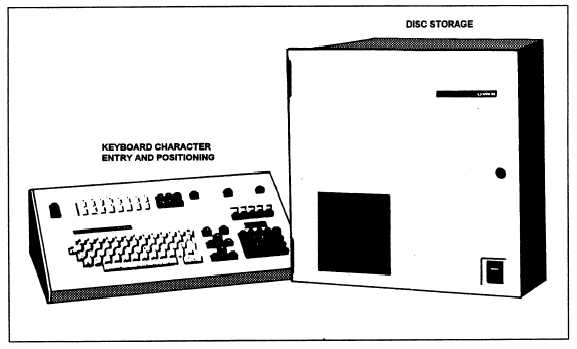Figure 14-16.—Character generator (CG).
You can limit details to the essential areas by using
Some of the more advanced CGs feature 14 to 16
simplified drawings. For example, if you want to
emphasize the state of Colorado on a map of the United
States, you could retrace the borders and darken the state
area with green or blue tints.
Keep written copy on charts to a minimum. Maxi-
mum clarity with minimum essentials must be your
chief objective.
Character Generator
When you have a lot of printed information to air,
such as sports scores or closing credits, you should use
a character generator (CG) (fig. 14-16). The CG is a
computer graphics system used widely in closed circuit
and broadcast television. It creates letters and numbers
in a variety of sizes and fonts and requires no special
skill for the user to make flawless letters.
A CG has a solid-state keyboard similar in
appearance to a microcomputer keyboard, except it
contains additional keys for specific CG functions. As
you create text, you may store it in RAM (random access
memory) and recall it as needed. Since RAM is cleared
when microcomputers are turned off, most CGs use a
floppy or hard disk drive system for permanent text
storage.
lines of 32 characters within the frill-screen scanning
area line-by-line memory recall, automatic centering,
word flash, word or line underline, stand alone titling,
titling over video and two-speed roll (or crawl) through
all or part of the memory. You may even program the
letters in certain color arrangements by using a colorizer.
A cursor helps you move information to any location on
the screen.
Although the CG is a timely means to display
information, you should not rule out the use of other
graphic support material.
Computer Graphics
Computer graphics, the newest elements of the
television medium, have all but replaced 35mm slides
for television work. This process starts with an
electronic picture recorded on videotape. The computer
operator converts the picture into a digital code format
and stores it either on the hard disk drive or a floppy
drive. When the image is needed, a graphic artist
retrieves it and converts it into an electronic picture.
Now he may paint or draw a picture using an electronic
pen and palette. The graphic artist can add or delete
information and change the colors of the picture and
letters at will while “on-the- air.” Some advanced
computer graphic systems have a wide range of colors
and can produce detailed animation.
14-17



